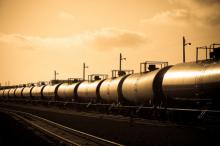Contributor: Ken Snyder, Gulf Energy Development
It has been more than five years since oil production in the Bakken started to take off, and one to two years since most of the energy market accepted that horizontal drilling and fracking technologies could work as well in crude plays as they have in natural gas. Crude oil production from the Montana and North Dakota sides of the Williston Basin is up from 149 Mb/d in Jan. 2005 to 615 Mb/d in Jan 2012. (Source: Bentek). Essentially all of the increase is Bakken.

As production has increased, so have logistic problems and capacity constraints. Production exceeded pipeline capacity many months ago. Rail transportation is limited by terminal capacity, availability of railcars, destination capacity, and track constraints. Truck gathering operations are limited by the availability of qualified drivers, housing, equipment and the size of unloading terminals. Integration across the modes of transportation is often loose and unstructured. Producers must prioritize drilling activities to coincide with the availability of gathering and transportation infrastructure, or be faced with potential shut-in, curtailment or significant development delays.
This situation is with us today in the Bakken, and is rapidly developing in other crude plays and basins like the Eagle Ford, Powder River, Niobrara, Permian and Anadarko. The same situation is destined to impact emerging plays such as the Utica.
What have we learned about the Bakken that can guide development in these other regions? How can the industry minimize the impact of logistical constraints on production growth?
The obvious answer is forward planning. But in the case of onshore crude oil, there are unique aspects of the commodity that make the concept of integrated logistical planning particularly important. Integrated logistical planning is a fancy term for a transportation system that encompasses truck, rail and pipeline infrastructure in a unified system. In some systems it also makes sense to add barge into the mix. When managed under a single umbrella, the four transportation modes become a much more efficient and powerful structure.
For example, relatively high cost, long distance trucking might be the primary transportation mode in the early development of a play. But as volumes grow, new rail facilities can be economically justified, reducing transportation costs. Eventually volumes may increase to a level which will support construction of a long-line pipeline, resulting in further cost reduction. Such a stepwise process will minimize the reoccurring series of constraints that have plagued Bakken transportation over the past few years.
To make sure that this is clear, I’ll say it one more way. You truck until you have enough volume to pay for rail. You rail until you have enough volume to pipe. And this transition is a planned, managed progression rather than the random development of unconnected projects.
And there is one more benefit of this approach. With rail in the mix, producers have the option to move barrels to the highest value market – depending on market conditions. In the crude oil business, the market means refineries. But there is a huge disparity between the values of different crudes at different refineries. And that value changes due to refinery configurations, downstream product values (gasoline, diesel, etc.), the availability of other crudes, and a myriad of other factors. And today all of these are in a state of flux – new refinery upgrading capacity, increasing volumes of light-sweet shale crude, etc. Consequently the differences in crude values are wide, volatile and getting more so. With rail as an alternative transportation mode, the producer can capture the optionality value of the best crude market at any point in time.
To the extent that this integrated transportation approach can be applied new to crude oil plays around the country, producers will minimize their transportation constraints and maximize their netback value at the wellhead.
-----------
Pipelines, Trains, and Trucks (riding with lady luck) - Paraphrase Ol' '55 – Eagles (Tom Waits)







